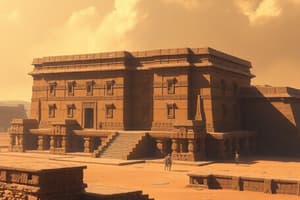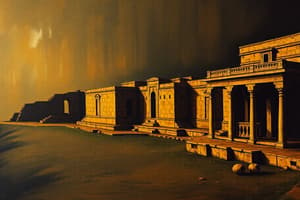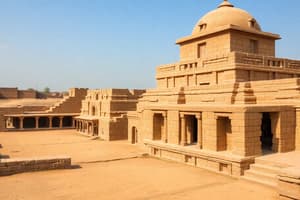Podcast
Questions and Answers
When did the Indus Valley Civilization exist?
When did the Indus Valley Civilization exist?
2500 - 1500 BC
Where was the Indus Valley Civilization located?
Where was the Indus Valley Civilization located?
Between Pakistan and Northwest India
The Himalayas contributed to the isolation of India from other civilizations.
The Himalayas contributed to the isolation of India from other civilizations.
True (A)
What was the capital city of the Indus Valley Civilization?
What was the capital city of the Indus Valley Civilization?
Who invaded the Indus Valley Civilization which led to its decline?
Who invaded the Indus Valley Civilization which led to its decline?
Which of the following is NOT a social class in Hinduism?
Which of the following is NOT a social class in Hinduism?
What is the Hindu belief in reincarnation called?
What is the Hindu belief in reincarnation called?
Who is considered the founder of Buddhism?
Who is considered the founder of Buddhism?
What forms the basis of Egyptian government?
What forms the basis of Egyptian government?
What river was central to the economy of ancient Egypt?
What river was central to the economy of ancient Egypt?
Which civilization is known for using Papyrus?
Which civilization is known for using Papyrus?
The Rosetta Stone was key to deciphering ancient Egyptian writing.
The Rosetta Stone was key to deciphering ancient Egyptian writing.
What is the central belief of Jainism?
What is the central belief of Jainism?
Flashcards
Indus Valley Civilization Time Period
Indus Valley Civilization Time Period
The Indus Valley Civilization flourished between 2500 and 1500 BC
Indus Valley Location
Indus Valley Location
Located in modern-day Pakistan and Northwest India
Himalayan Influence
Himalayan Influence
The Himalayas played a crucial role in isolating the Indus Valley and shaping its unique culture
Harappa & Mohenjo-Daro
Harappa & Mohenjo-Daro
Signup and view all the flashcards
Indus Valley Public Works
Indus Valley Public Works
Signup and view all the flashcards
Indus Valley Civilization Fall
Indus Valley Civilization Fall
Signup and view all the flashcards
Aryan Characteristics
Aryan Characteristics
Signup and view all the flashcards
Hinduism's Core Principle
Hinduism's Core Principle
Signup and view all the flashcards
Egyptian Government Structure
Egyptian Government Structure
Signup and view all the flashcards
Nile River's Significance
Nile River's Significance
Signup and view all the flashcards
Study Notes
Indus Valley Civilization
- When: 2500-1500 BCE
- Where: Between Pakistan and Northwest India today
- Himalayas: Played a crucial role in shaping Indian civilization by isolating it, leading to a unique culture
- Hindu Kush: Served as the only gateway to the Indus Valley.
- Harappa & Mohenjo-Daro: Twin capital cities, Harappa being a large village, & Mohenjo-Daro-an administrative center.
- Public Works: Included public bathrooms, assembly halls, and wide streets.
- Art & Architecture: Featured temples & statues, notable for the Great Bath (a sacred bath used for cleansing)
- Advanced Measurement: A notable element of the civilization.
- End of Civilization: Invaded by Aryans, sudden attack on Mohenjo-Daro, & Harappa being destroyed.
- Aryans: Nomadic people with no known art, architecture, or written works.
- Social Classes (Aryans): Warrior-nobles, priests, and commoners.
Indus Valley Religions
- Hinduism: A way of life with no founder believing in reincarnation (Samsara).
- Hindu Social Classes: Brahmins (priests and teachers), Kshatriyas (warriors and rulers), Vaishyas (farmers, traders and merchants), Sudras (laborers), and Dalits/Untouchables (outcasts).
- Hinduism Principles: Brahman (return to Brahman), Dharma (a person's life purpose), and Karma.
- Buddhism: A path to enlightenment with founder Siddhartha Gautama.
- Hinayana (Old Buddhism): A type of Buddhism
- Mahayana (New Buddhism): A type of Buddhism in which one god rules over lesser gods.
- Jainism: Founded by Mahavira (a great hero). Key principle is Ahimsa (non-violence).
Egyptian Civilization
- Government: Theocracy, Pharaoh treated like a god, Pharaoh's decisions the law.
- Unification of Egypt: King Menes unified upper and lower Egypt using the Nile River.
- Cities: Memphis & Thebes (capital).
- Kingdoms (1st): Old Kingdom: Building of pyramids representing wealth & power of pharaohs. Ended due to high costs, civil wars, and invasions; collapse marked by crop failures.
- Kingdoms (2nd): Middle Kingdom: Flourishing trade, mummification of common people. Arts and temples, period of peace in Egypt. Ended due to leadership power struggles & Hyksos attacks
- Kingdoms (3rd): New Kingdom: Age of empire, expansion through military conquests, and peace. Ruled by dynasties. Ended due to Assyrian and Persian invaders.
- Egyptian Social Classes: Pharaohs, Viziers/Priests, Scribes, Craftsmen, Peasants, Slaves/Servants.
- Women: Respected, could inherit, sell properties, and enter business.
- Occupation: Artisans, dancers, acrobats, priests, and servants
- Writing: Hieroglyphics (pictures), Hieratic (formal)
- Rosetta Stone: Key to deciphering ancient Egyptian writing.
Egyptian Religion
- Polytheistic: Belief in many gods.
- Book of the Dead: Collection of rituals, customs, spells etc for life after death.
- Mummification: Preservation of bodies for the afterlife.
- Tombs: Homes of the dead.
- Afterlife Rituals: Osiris weighing of the dead person's heart based on if they are a good or a bad person.
Chinese Civilization
- Family/Government: Respect for elders, men controlling family (elder woman authority), women following men, Emperor.
- Religious Beliefs: Supernatural forces, life after death, and veneration of ancestors.
- Oracle Bones: Used to communicate with the gods by asking questions and looking at the cracks in turtle shells or oxen bones to read the answer.
- Social Class: King/Emperor, Aristocrats, Peasants.
- Writing: People could learn the same writing language even if spoken languages were different.
- Rivers: Yangtze (Chiang Jiang) and Huang He (Yellow River). Yangtze River made China half isolated.
- Environmental Challenges: Huang He flooding and borders (China's isolation), natural disasters, and barbarians (outside groups).
- Mandate of Heaven: Ruler's justified rule based on people's well-being . Removal if things go poorly.
- Fall of Dynasties: Political instability, peasant revolt, noble revolt, barbarian invasion.
- Silk Road: Important trading route spreading ideas, beliefs, & religion .
- Great Wall: Public work built from Han to Ming dynasty to protect borders.
- Terracotta Warriors: Art and architecture built to protect the Emperor’s tomb.
- Forbidden City: Built for the Emperor; no ordinary people allowed inside.
- Chinese Civilization Contributions: Gunpowder, papermaking, printing, compass, Diamond sutra, civil service exams.
- Chinese Schools of Thought: Confucianism (Founder: Confucius, do not do unto others what you do not want done unto you), Daoism (Founder: Laozi, humility).
Korean Civilization
- Location: Korean Peninsula between China and Japan - known for High mountains and sparkling Streams, DMZ separating North and South Korea.
- Gojoseon: Earliest Korean civilization before divisions.
- Three Kingdoms of Korea: Koguryo, Baekje/Paekche, Silla (Koguryo was the largest; Baekje/Paekche shared culture & language with China and Japan; Silla was the smallest, but became the strongest).
- Koguryo: Powerful culture, advanced tech, and close ties to China (founder was Jumong).
- Baekje/Paekche: Connected to China and Japan due to maritime trade. Buddhism and Chinese characters spread throughout Asia.
- Silla: Eventually strongest, centralized government, hierarchical social classes, and allied with China’s Tang Dynasty.
- Unified Silla: Three kingdoms fought for control, Tang Dynasty of China aided Silla's victory in unifying the peninsula bringing peace.
- Koryo Dynasty: 400 years of rule, civil service based on examinations, and spread of Buddhism.
- Joseon Dynasty: Founded by Yi Song-gye (new dynasty) and the longest Korean Dynasty known as the Yi dynasty; capital at Hanseong (Modern Seoul), and Confusian government.
- Sejong the Great: Created Hangul alphabet, a writing system to help the commoners become literate.
- Korean Society: King, Yangban (Nobles), Chungin (Middle Class), Sangmin (Common people, lower social status), and Cheomin (slaves, butchers shamans, etc).
- Korean Family: Duty, loyalty, honor in the family head (father). Importance of bowing to show respect.
- Korean Shamanism/ Confucianism: Cultural & Religious practices, Joseon promoted Confucianism (ethics, relations, and respect for tradition).
Early Indian and Chinese Influences on Southeast Asia (SEA)
- Purpose of influence: India came to SEA to trade and spread Buddhism and China came to SE Asia to trade and colonization.
- Material Culture: India (rouletted ware, knobbed vessels, glass beads, semi-precious stones, and ivory), and China (ceramic vessels, bronze artifacts).
Japanese Civilization
- Migration from mainland Asia: Migrated from the Asian mainland divided into clans.
- Geographic Location: River valleys, mild climate and sufficient rainfall. Importance of sea (fishing industry)
- Zen Buddhism: Meditation focused, based on Mahayana Buddhism, aimed at enlightenment (seating meditation).
- Kami Tree: Sacred tree, part of Shinto religion.
- Scriptures (Japan): Haiku, Tanka, Kanji, Hiragana, Katakana .
- Japanese Culture: Importance of societal norms, respect, traditions, values.
- Japan Dramas: Noh and Kabuki (traditional performances)
- Women: Lived basic life, depended on husbands.
Studying That Suits You
Use AI to generate personalized quizzes and flashcards to suit your learning preferences.




